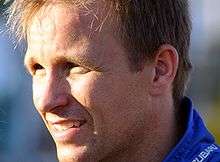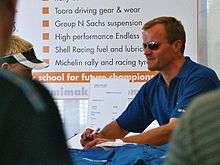Subaru World Rally Team
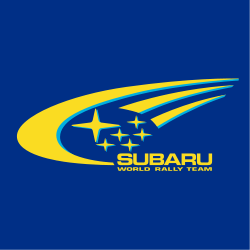 | |
| Full name | Subaru World Rally Team |
|---|---|
| Base |
|
| Team principal(s) | David Richards[1] |
| Technical director | Richard Taylor[1] |
| Drivers |
|
| Co-drivers |
|
| Chassis | Subaru Impreza |
| Tyres | Pirelli |
| World Rally Championship career | |
| Debut | 1993 |
| Constructors' Championships | 3 (1995, 1996, 1997) |
| Drivers' Championships | 3 (1995, 2001, 2003) |
| Rally wins | 47 |
The Subaru World Rally Team (SWRT) was Subaru's World Rally Championship (WRC) team. It used a distinctive blue with yellow color scheme that is a throwback to the sponsorship deal with State Express 555, a BAT cigarette brand popular in Asia.[2] 555 logos were found on Subaru cars from 1993 to 2003.[2] Subaru's WRC efforts date back to 1980, however, the team, in its current form, has existed since 1989, when the British firm Prodrive took over its operations, and its base moved from Japan to Banbury, England.[2][3]
Subaru used the team to showcase its symmetrical all wheel drive technology.[4] It has credited the increased sales of its vehicles, especially the Subaru Impreza, with its success in the World Rally Championship, in addition to popularizing its all-wheel-drive system.[5][6][7]
Its 2008 season drivers were Petter Solberg with co-driver Phil Mills, and Chris Atkinson with co-driver Stéphane Prévot. David Richards was the team's Principal, and a founder and chairman of Prodrive.[1] Paul Howarth was the team's operations director and team manager. He replaced David Lapworth in 2006.[1][8][9] Richard Taylor is the team's managing director.[1]
The team was historically an extremely strong one, competing in the WRC longer than any other manufacturer team in their current form. It has won the manufacturers' championship three times in 1995, 1996, and 1997, and the drivers' championship three times, in 1995, 2001, and 2003. The team's performance since the 2005 season, when Petter Solberg secured second position in the driver's championship, has been far lower than expected and the subject of much criticism. [10] The team's 2006 season, one that has been described as "disappointing" by Richard Taylor, was the subject of a Discovery Channel series called Engineering the World Rally which aired in 2007.[8][11][12][13] The 2007 season was little better, and called the "second season from hell" by Phil Mills.[14] The team withdrew from WRC competition at the end of the 2008 season due to widespread economic downturn.[15]
Racing history
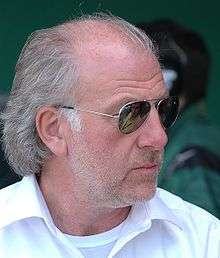
Although Subaru had participated in the World Rally Championship at various times since 1980, it was not until September 1989, that the Subaru World Rally Team, in its current form, was created.[16] Subaru Tecnica International (STi) president Ryuichiro Kuze forged a partnership with the British firm Prodrive to prepare and enter the recently introduced Legacy RS in the World Rally Championship.[3]
1980–1989
Subaru's initial forays into the World Rally Championship were with Subaru Rally Team Japan, run by Noriyuki Koseki, the founder of Subaru Tecnica International.[17] The first Subaru car entered a world rally at the 1980 Safari Rally and since that, the team only participated in a few events per season, driving the Subaru Leone.[18] Drivers in the early years included Ari Vatanen, Per Eklund, Shekhar Mehta, Mike Kirkland, Possum Bourne, and Harald Demuth.[2] The best result and only podium was achieved by Bourne at the 1987 Rally New Zealand by finishing third. With the start of the Prodrive effort, the teams competed in parallel, before being folded into each other.[17]
1990–1992
Subaru entered its first Prodrive developed car, the Group A Subaru Legacy RS in the 1990 season, piloted by Finnish driver Markku Alén.[19] Alen remained with the team through the 1991 season. His successes included 4th place in the 1990 Rally Finland, also known as the 1000 Lakes Rally, and in 1991, a 3rd and two 4th places.[19] For the 1992 season, Subaru only entered seven of the fourteen WRC events, preferring to demonstrate the car's ability on gravel rallies. The drivers for 1992 were Finn Ari Vatanen with co-driver Bruno Berglund and Scotsman Colin McRae with co-driver Derek Ringer.[3] Both drivers were able to achieve second-place finishes.[3] Colin McRae also won the British Rally Championship in 1991 and 1992.
1993

For the 1993 World Rally Championship season, the Subaru team debuted its now distinctive blue and yellow color scheme, along with a new title sponsor, State Express 555.[20] Ari Vatanen and Colin McRae remained the primary drivers, with the season being McRae's first complete year of World Rally Championship competition.[20] Markku Alén, returned part-time to the team after a brief stint at Toyota in 1992, and took 4th for Subaru in Portugal.[19] McRae took the first win for Subaru, at the eighth event of the season, Rally New Zealand, the last outing for the Group A Subaru Legacy rally cars.[20][21] At the next event, Rally Finland, Subaru debuted their new Prodrive developed Group A Impreza rally car, known as the Impreza 555, driven by Vatanen and Alén.[22][23] Alén crashed on the first stage, and did not drive for Subaru again. Vatanen, however, showed the car to be quick, even leading the rally at one point, and managing a second-place finish.[20] At the end of the season, Vatanen took seventh in the Drivers’ Championship, and Colin McRae finished in fifth with 50.[20] Subaru finished third in the Manufacturers’ Championship.[20] Other drivers also competed for the Subaru team at selected events. New Zealand driver Possum Bourne, veteran of Subaru's early days, joined the team for the Rally New Zealand and Rally Australia.[20] Piero Liatti competed in Rallye Sanremo and Rally Great Britain. Drivers Richard Burns and Alister McRae had competed in the British Championship, which Burns won, and appeared again in Legacies for Rally Great Britain,[20] where Burns finished seventh and McRae tenth. Drivers Per Eklund and Hannu Mikkola drove for the team in Rally Sweden.[20]
1994–1995
In 1994, former World Rally Drivers' Champion Carlos Sainz joined the team with co-driver Luis Moya, and took the Impreza 555 to its first win at the Acropolis Rally in Greece.[24][25] It later took wins in New Zealand and Great Britain with McRae at the wheel.[20][21] In the Championship for Manufacturers, they achieved a second-place finish, behind Toyota, with Sainz placing second in the driver's championship, and McRae placing fourth.[25] Other drivers for the Subaru team in 1994 included Patrick Njiru, competing in the Safari Rally, Richard Burns in the Safari Rally and Rally Great Britain, Possum Bourne in New Zealand, and Piero Liatti at Rallye Sanremo.[20][25]
For the 1995 season, the primary drivers remained Sainz in the number 5 car and McRae in the number 4 car. Sainz won the season opening round at the Rallye Monte Carlo, while McRae crashed out of the event.[26] At Rally Sweden, Sainz, McRae, and third driver Mats Jonsson all retired with engine trouble.[27] Sainz won again at the Rally Portugal, while McRae finished in third place.[28] At the Rallye de France, Sainz, McRae, and third driver Piero Liatti finished in the fourth, fifth, and sixth places respectively.[29] At Rally New Zealand, McRae took his first win of the season.[30] Other drivers for the team included Possum Bourne, who finished in seventh place, and Richard Burns who retired with a mechanical failure.[30] At the Rally Australia, McRae took second place.[31] Sainz retired after his radiator failed, while third driver Bourne retired after an accident.[31] At the Rallye Catalunya, Subaru locked out the podium with a 1–2–3 finish.[32] Sainz took first, McRae took second, and third driver Piero Liatti finished third.[32] Sainz's first-place finish in Catalunya left he and McRae tied for points going into the last event of the season, the RAC Rally of Great Britain.[33] McRae won out, taking first place at his home event, clinching his first and only Driver's Championship, a first for the Subaru team.[20][21] Sainz finished close behind in second place, giving him second in the Championship, and third driver Richard Burns finished in third place, giving the team a second consecutive 1–2–3 finish.[20][33] Between McRae and Sainz the team managed to win five of the season's eight rallies for Subaru, winning the team its first Constructors Championship.[20][21][34] At the end of the season, Sainz left Subaru to join Ford World Rallye Sport.[35]
1996

For the 1996 World Rally Championship season, Colin McRae was again the lead driver for Subaru.[20] Following his 1995 Championship victory, his Impreza 555 wore the #1 plate.[35] He was joined by team drivers Kenneth Eriksson, in the #2 car, and Piero Liatti, with their co-drivers, Staffan Parmander and Mario Ferfoglia, respectively.[20][35] At the first event of the season, Rally Sweden, McRae took third, Eriksson took fifth, and Liatti took twelfth.[36] 1994 World Drivers' Champion Didier Auriol also drove for the Subaru team in Sweden, taking his #3 car to tenth place.[36] At the second round, the Safari Rally, Liatti's number was changed from #10 to #3.[37] He took fifth place.[37] McRae took fourth while Eriksson took second.[37] At the Rally Indonesia, Liatti finished in second place, while McRae and Eriksson both retired following accidents.[38] McRae's first victory of the season was at the Acropolis Rally, the fourth round of the championship.[20][39] Liatti and Erikkson placed fourth and fifth respectively.[39] Eriksson took third and Liatti fifth at Rally Argentina.[40] McRae crashed out of Rally Argentina and the following event, Rally Finland.[40][41] Liatti didn't compete in Finland, though Eriksson managed to finish in 5th place.[41] McRae, Eriksson, and Liatti finished 4th, 2nd, and 7th respectively at Rally Australia.[42] In Sanremo, McRae took victory, with Eriksson finishing in 5th.[20][43] Liatti retired following an electrical failure.[43] At the last round of the season, Rallye Catalunya, McRae took a second consecutive victory.[20][44] Subaru took a 1–2 finish with Liatti finishing second.[44] Eriksson finished in seventh position.[44] Thanks to consistent podium finishes, Subaru successfully defended its Constructors' Championship, but McRae lost the Driver's Championship to Tommi Makinen.[20][21]
1997–1998
For 1997, McRae again led the team, however his co-driver Derek Ringer was replaced by Welshman Nicky Grist.[45] Secondary driver/co-driver teams included Piero Liatti/Fabrizia Pons (first in Monte Carlo), Olivier Burri/Christophe Hofmann and Kenneth Eriksson/Staffan Parmander (first in Sweden and New Zealand).[45] Once again the team successfully defended its Constructors Championship, winning eight victories out of the fourteen rallies, but McRae again lost the Driver's Championship to Tommi Makinen, this time by just one point.[21][45]
In 1998 the team had an almost unchanged line-up, although Jahu Kangas/Pentti Kuukkala and Jarno Kytölehto/Arto Kapanen participated in one round each.[45] McRae took wins in Portugal, Corsica and Greece. However, bad weather and mechanical failures hurt the team, and Subaru and McRae finished third in their respective championships.[45] At the end of the season, McRae left the team to join Ford, with the tantalizing prospect of driving their brand-new car, the Ford Focus WRC.[21]
1999–2001
Subaru had an all new line up for the 1999 season, with the nominated driver/co-driver teams of Richard Burns/Robert Reid, Juha Kankkunen/Juha Repo, and third team of Bruno Thiry/Stéphane Prévot.[46][47][48] The new car, the WRC99, featured an electronically controlled Paddle shifter with a drive-by-wire throttle. Due to technical difficulties, the team struggled until the season's 7th round in Argentina.[48] From there on, the teams earned the podium in seven out of eight events, with five wins, three of which were 1–2 finishes.[48] Subaru finished second in the Manufacturers’ Championship, just four points behind Toyota. Burns scored victories in Greece, Australia, and Wales, for second place and Kankkunen took fourth in the Drivers’ Championship, with wins in Argentina and Finland.[48]
Burns and Kankkunen continued to drive for Subaru for the 2000 season, with Petter Solberg joining the team halfway through the season, driving in the Rallye de France.[49][50][51][52] The team finished third in the championship, and Burns took second in the Drivers' Championship for the second year in a row.[51]
Burns and Solberg composed Subaru's nominated line-up for the 2001 season with Markko Märtin/Michael Park and Toshi Arai/Tony Sircombe competing in selected events.[51] Subaru again won the Driver's Championships in 2001 with Richard Burns and co-driver Robert Reid. Burns left Subaru for Peugeot at the end of the 2001 season.[51]
2002–2003
For the 2002 season, Burns was replaced by Tommi Mäkinen and co-driver Kaj Lindström. Petter Solberg continued with the team, and Pasi Hagstrom was the team's test driver.[53][54] Following the October 2001 signing of four time driver's Championship winner Mäkinen, expectations for the team ran high.[54] However, after a season opening win in Monte Carlo, he was only able to finish five more events during the entire season.[54][55][56] His teammate, Solberg fared much better, finishing nine events, five of which were podium finishes, including his first ever WRC win, at Rally Great Britain, the season's last round.[54] The win propelled him past Ford's Carlos Sainz into second in the Drivers' Championship.[54]
For the 2003 season, the driver line-up remained unchanged from the previous year. Solberg drove the #7 car, Mäkinen the #8 car. The season got off to a poor start, with neither driver finishing the Rallye Monte Carlo.[57] Solberg then scored four outright wins, in Cyprus, Australia, France, and finished the season with his second straight win in Britain, securing him the Driver's Championship for himself and co-driver Phil Mills, narrowly beating Sébastien Loeb by one point.[58][57][59] The team only managed to achieve third place in the manufacturers' championship, beaten by Citroen and Peugeot.[57][60] At the end of the season, Tommi Mäkinen retired from the WRC.[55]
2004–2005
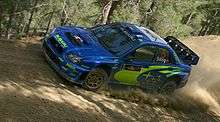
For the 2004 season, Solberg was joined by Finnish driver Mikko Hirvonen and his co-driver Jarmo Lehtinen.[61] Subaru managed to consolidate third place in the Manufacturer's Championship again, while Solberg was second in the Driver's Championship, winning five of the season's rallies: New Zealand, Greece, Japan, Italy and a third consecutive win at Rally Wales.[50] Hirvonen ended the season in seventh place, failing to impress the Subaru team management.[61] He was not re-signed for the 2005 season.[62]
In 2005, Petter Solberg again led the team in the #5 car, while Hirvonen was replaced by Chris Atkinson in the #6 car. The young Australian debuted with the Uddeholm Swedish Rally, and finished third at Rally Japan.[63] Petter Solberg achieved back-to-back victories in Mexico and Sweden, early in the season.[64][65] He finished the season behind Sébastien Loeb, tied for second place with Marcus Grönholm.[62] In the Manufacturer's championship, Subaru only managed to finish fourth overall, ahead of Mitsubishi and Skoda.[66]
2006
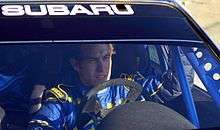
Petter Solberg again led the team throughout the 2006 season, with the second car piloted by Chris Atkinson and co-driver Glenn MacNeall on gravel events, while on tarmac events, it was driven by ex-Formula One driver Stéphane Sarrazin.[67] The WRC2006 had several changes from the previous year's car due to rule changes which banned active differentials as well as water injection, as well as mandating that teams must re-use cars and engines on selected ‘pairs’ of events.[68][69] Due to the rule changes, the car was introduced on the first round of the season.[67][68]
Subaru's season got off to a poor start, with Solberg unable to score in the first two rallies due to mechanical failures.[70] Due to the teams lacklustre performance, after a decade of running the team, team boss David Lapworth was replaced by Paul Howarth.[8][70] Not until the third rally of the season, Rally Mexico, would Petter manage to score, achieving a second-place finish.[71] He picked up another second-place finish at Rally Argentina, and again at Rally Australia.[72] The team finished the season in third place in the manufacturer's championship, while Solberg finished in sixth place in the driver's championship.[73][74] However, the team was not able to achieve a single win, and achieved podium results only four times.[74] Subaru's 2006 season was characterized as disappointing, and was the subject of a Discovery Channel series called Engineering the World Rally.[8][11][12][13] In the programme, Subaru's dismal season was described as 'The Season from Hell'.
2007

Solberg again led the team for the 2007 season, driving the #7 Impreza. Sarrazin left the team, leaving Chris Atkinson as the single number two driver, piloting the #8 car.[75] Atkinson managed to grab fourth place at the season opening event in Monte Carlo, after passing the works Ford of Mikko Hirvonen.[63] At the 2007 Rally Portugal, Solberg came in second, following the Ford cars' disqualification due to the glass in their rear windows being too thin. Following the rally, Atkinson's co-driver, Glenn MacNeall, elected to leave the team, and was replaced by Stéphane Prévot, who had previously been with the team as co-driver for Bruno Thiry.[76][77] At the 2007 Acropolis Rally Solberg managed to achieve a podium position.[78]
After the summer break, the team was joined at the 2007 Rally Finland by Xavier Pons and co-driver Xavier Amigo, driving a third car, #25, not nominated for manufacturer points.[79] However, in the rally, Solberg had to retire on day two, after monstrous handling and steering problems which the team engineers were unable to deal with.[80][81] Solberg finished fifth in Ireland, calling it "the most difficult rally he has ever done."[82] At the final event of the season, Wales Rally GB, Solberg won the battle for fourth with Dani Sordo, propelling Subaru to third place in the manufacturer's standings.[83] In the driver's championship, Solberg came in 5th, while Atkinson took 7th.[84] Richard Taylor called the season a "poor" one, with Subaru only achieving two podium finishes, and no overall wins for the second year in a row.[11][84] Phil Mills called it the "second season from hell."[14]
2008
Petter Solberg and Chris Atkinson continued with the team through the 2008 season.[50][63] Xavier Pons left the team, although there is a possibility that he will return.[85][86] With the FIA mandated switch to Pirelli tires, tyre mousse had been banned, and fewer compounds were available.[87][88]
At the first rally of the season, the 2008 Monte Carlo Rally, Atkinson scored his first podium finish on tarmac, after a close battle with François Duval while Solberg finished in fifth.[86][89] In the 2008 Swedish Rally, Solberg finished in fourth place while Atkinson finished in 21st position following a spin on Special Stage 3, which cost him over 15 minutes.[50][90][91] Immediately after the Swedish Rally, the team completed a gravel test in Spain, in preparation for Rally Mexico, the last test using the WRC2007 car.[92] At the 2008 Rally Mexico, Atkinson placed second, his best ever result.[93] Solberg was forced to retire on the second day after a driveshaft failure to his front left wheel. He continued under SupeRally rules on Sunday, finishing 12th.[93][94] Going into the final day of the 2008 Rally Argentina, Solberg and Atkinson were comfortably in second and third position, poised to put two cars on the podium, a feat Subaru has not accomplished in several years.[95][96][97] However, on Special Stage 19, Petter's car suffered an electrical failure, forcing him to retire.[96][98] Atkinson inherited Solberg's position, and achieved a second-place finish for the second consecutive time.[10][97][99] At the 2008 Jordan Rally, on SS6, Solberg's retired after his Impreza suffered from a damper failure, which then spilled oil, lighting a fire under the hood of the car.[100] Solberg restarted under SupeRally rules on Saturday, but crashed on the day's final stage after brake problems.[101][102] Atkinson managed to secure a third podium in a row, following the suspension failure of Latvala, and the retirements of Solberg and Loeb.[101][102]
Withdrawal from WRC
On 16 December 2008, it was announced that Subaru would no longer be competing in the World Rally Championships.[103] The decision was taken by Subaru’s parent company, Fuji Heavy Industries (FHI), partly as a result of the economic downturn but also because it was felt Subaru had achieved its sporting and marketing objectives. Ikuo Mori denied that alterations to the WRC technical regulations in 2010 or a rumoured deterioration in the working relationship with Prodrive had any impact on the decision. He also said that the possibility of a Subaru car back in the top category of WRC in the future is not zero, but for this moment there can be no assumption of a comeback.[104]
Vehicle development
Group A Leone, 1980–1989
As Subaru Rally Team Japan, Subaru entered the first World Rally with the second generation Group A Subaru Leone DL at the 1980 Safari Rally. In 1984 the model was changed to the 3rd generation Leone coupé, one year later installed with a turbo. The other model used simultaneously with the coupé turbo until 1989 was the Leone sedan RX Turbo.[105]
Group A Legacy RS, 1989–1993
Prodrive's vehicle development began upon the team's formation in September 1989, creating the Group A Subaru Legacy RS rally car, based on the road going Subaru Legacy sedan. The Legacy was powered by a longitudinally mounted boxer engine, giving it a low centre of gravity. Already equipped with a symmetrical all wheel drive system, it made a good starting point for a rally car. David Lapworth described the development of the car as a "steep learning curve." The car lacked power and a weak transmission and braking system also hampered the car.[106] To correct its flaws, Prodrive completed a new car, the 1992 Legacy RS, which featured a totally redesigned fuel injection system, during the 1991 season, introduced on the season's last rally.[3][106] The team campaigned the 1992 Legacy during the first part of the 1993 season, and on its last rally, achieved the car's first and only win.
Group A Impreza GC, 1993–1996
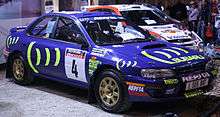
For 1993, Prodrive recognized that a smaller, nimbler car would make a better platform for a rally car, and work on a Group A Impreza rally car began. It was 160 mm shorter in overall length with a 60 mm shorter wheelbase, as well as having a more neutral front/rear weight ratio. It also featured active differentials, a first for a rally car.[107] At the 1000 Lakes Rally, Subaru debuted their new Prodrive developed Impreza derived Group A rally car, driven by Vatanen and Alén.[22][23] Vatanen drove the car to second place on its debut.
In 1994, the Subaru team switched from Michelin to Pirelli tires.[2]
For the 1995 season, the FIA mandated more restrictive air intakes in an effort to slow the cars down.[20] Subaru countered this by introducing a new boxer engine with revised camshafts and a different compression ratio.[20]
World Rally Car Impreza GC, 1997–2001

For 1997, the FIA replaced the Group A formula with a new formula called World Rally Car. This gave teams greater latitude in design and materials including vehicle width, suspension geometry, aerodynamics, intercooler capacity and engine modifications.[45] This led to a totally redesigned car, the WRC97, featuring modified camshafts, cylinder ports and combustion chambers.[45] The new body had two doors. The width of the car increased to 1,770 mm (69.9 in) with a revised suspension geometry.[45] Power increased to 300 hp @ 5500 rpm, and torque was now 347 lb ft.[45]
The Impreza WRC98 was an evolution of the earlier WRC97, with computer controlled active differentials in the front, rear, and centre, and an electronic throttle.[45] Mechanical failures were common and took the team out of contention for the title.[45]
The WRC99, introduced at the first round of the championship, featured an electronically controlled, hydraulically actuated semi-automatic transmission with a drive-by-wire throttle, allowing the cars to be shifted with steering wheel mounted paddles, similar to F1 cars.[108] This allowed the driver to shift gears faster, and reduced the chance of dog gear wear. Due to technical difficulties, the team struggled until the season's 7th round in Argentina.[48] However, the car helped prove much of the technology seen on later cars. Subaru was the first rally team to implement this technology, which has been used on all WRC cars until it was forbidden by the 2011 championship rules.
Although the WRC2000 looked almost identical to the WRC99, underneath the sheet metal, its execution was radically different. Developed by Prodrive engineer Christian Loriaux, the team used the lessons learned from the WRC99 and applied them in the WRC2000's 10-month development, in which over 80% of the car's mechanical and electronic components were redesigned.[52][109] The car debuted, and drove to victory, at the fourth event of the season, Rally Portugal.[52]
World Rally Car Impreza GD, 2001–2008
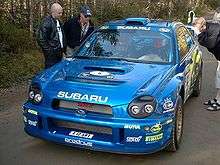
The WRC2001 featured an entirely new look, based on the GD chassis Impreza WRX.[110][111] The new body had four doors (instead of two), and featured revised aerodynamics, improved weight distribution, and a lower centre of gravity.[51] However, all the mechanical development from the previous year, including the engine, suspension, and drivetrain remained, with subtle refinements.[51]
The WRC2002 was introduced at Corsica, and looked largely the same as the previous year's car.[54] However, development of the car continued throughout the season.[54] Improvements were made to the driveshaft, transmission housing, and steering column, as well as to the turbo-charger and manifold, which was changed from a 4–2–1 configuration to a 4–1 configuration.[54] Savings found in modified brackets, wiring, and glass reduced weight by 33 lbs.[54]
The WRC2003 was introduced at the 2003 Rallye Monte Carlo.[112] It featured a revised look based on the updated Impreza introduced the previous year.[112] Technical improvements were made to the turbocharger and engine, aiming to increase torque at lower RPMs allowing greater driveability.[57][112] The car's body shell was made both lighter and stiffer.[57][112] Throughout the year modifications were made to the car's suspension.[57]
The WRC2004 did not feature many cosmetic changes from the previous year's car, but did have refinements in the engine and body panels. It was introduced at Rally Mexico.[113] A revised gearbox was introduced halfway through the season.[108]
The WRC2005 was introduced following 12 months of joint development by Subaru and Prodrive, on 11 March 2005 at Rally Mexico.[114] Its re-styled bodyshell was stiffer, and 30 mm wider to allow a wider track.[114] The car featured more composite body panels, including front and rear wheel arches and bumpers in order to decrease weight.[114] Engine enhancements included a lightened flywheel and revised IHI turbocharger.[114] Revised water injection and fuel injection systems were also introduced.[58][114]
The WRC2006 had several changes from the previous year's car due to rule changes which banned active differentials as well as water injection, as well as mandating that teams must re-use cars and engines on selected ‘pairs’ of events.[68][69] Due to the rule changes, the car was introduced on the first round of the season.[67][68]

The WRC2007, a revised version of the earlier year's car, was introduced at the fourth round of the championship, Rally Mexico. It featured new dampers, a different radiator and intercooler arrangement, as well as improved weight distribution, suspension geometry and differential set-ups.[58] It was considered to be underachieving compared to the newly introduced 2007 Focus WRC and the all-new Citroen C4 WRC.[14] The car suffered from extensive handling problems, resulting in Subaru withdrawing from Rally Finland on the second day of the rally.[115][116]
Each transmission in the WRC2007 takes 85 hours build, and costs over ₤75,000.[117] The front and rear differentials are similar while the centre differential is unique.[117] Each takes around 16 hours to build costs about ₤20,000.[117] The cases for the transmission and differentials are constructed from magnesium to reduce weight.[117] Filled with oil, the transmission weighs 95 kg, and a differential weighs 25 kg.[117] The car's engine, transmission and differential are individually oil sealed, so that they can be removed and replaced without fluid loss.[117] This also helps the team replace the components in 10–12 minutes. The transmission's lubrication system has a 4.5 litre capacity and includes an oil pump to help control differential temperatures, which usually operate around 100C.[117] The transmission retains the roadgoing Impreza's H pattern but utilizes a hydraulically actuated and electronically controlled semi-automatic gearshift.[117] The hydraulic gear shift system operates at a pressure of 2,500psi, allowing gear shifts to be completed in less than .1 seconds.[117]
World Rally Car Impreza GE, 2008
In December 2007, Subaru began testing the WRC2008, based on the all new GE chassis Impreza WRX.[118] The 2008 car is expected to benefit from a decreased polar moment of inertia due to smaller overhangs, and also features a double wishbone rear suspension. However, Prodrive found this setup inferior, and converted the rear suspension back to the original MacPherson design.[119] However, an updated 2007 car will be used for the first few rallies, with the 2008 car introduced after that.[86] Markko Märtin signed a deal to become the official test driver for the Subaru team in 2008, and has thus far done the majority of the testing on the WRC2008.[120] During a 4-day test at Sardinia between 30 April and 3 May 2008, Petter Solberg and Chris Atkinson drove the WRC2008 for the first time. A date for its debut was still not given.[121] On 20 May 2008, the Subaru World Rally Team confirmed its new Impreza World Rally Car (WRC2008) will make its WRC debut at the Acropolis Rally of Greece, beginning on the 29th of May. On the cars rally debut, the WRC2008 scored its first podium finish with Petter Solberg placing 2nd in the Acropolis Rally.[122]
Vehicle Preparation
Before each rally, each bodyshell is completely rebuilt.[4] In 1993, each bodyshell rebuild took 160 hours.[5] In 2003 it took 650 man hours.[4] In 2006 it took 780 hours.[5]
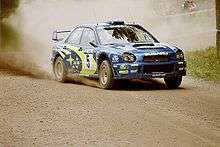 Burns' WRC2001
Burns' WRC2001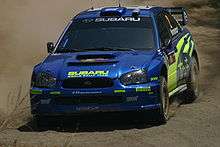 Hirvonen's WRC2004
Hirvonen's WRC2004 Atkinson's WRC2006
Atkinson's WRC2006 Prototype of the WRC2008
Prototype of the WRC2008
Technical personnel
Graham Moore is the overall chief engineer. Moore was a member of the team from 1991–2002, and then rejoined the team in 2006.[123] Jonathan Carey is the chief engineer for Petter Solberg and Richard Thompson is the chief engineer for Chris Atkinson.[1] Chris Wattam is the chief mechanic.[1]
Notes
Note on vehicle nomenclature: Prodrive and Subaru have different nomenclature for the same vehicles. In information published by the Subaru World Rally Team, for cars produced from 1997 to 2000, the car is referred to as the WRCXX, with XX being the last two digits of the year it was produced, e.g. WRC99.[106] For years 2000 forward, the car is referred to as the WRCXXXX, XXXX being the year it was produced, e.g. WRC2003.[106] Prodrive, however, refers to the cars using a different nomenclature.[111] The earliest record of this occurred with the WRC99, which Prodrive referred to as the S5. Each following car got a new designation: the WRC2000 is equivalent to the S6, WRC2001 is equivalent to the S7, WRC2002 is equivalent to the S8, WRC2003 is equivalent to the S9, WRC2004 is equivalent to the S10, WRC2005 is equivalent to the S11, WRC2006 is equivalent to the S12, and the WRC2007 is equivalent to the S12b, and the WRC2008 is equivalent to the S14. The S12b Imprezas that were used in 2008 before the S14 came, due to some differences, are sometimes referred to as S12c; however, this nomenclature is not official.[111][124][125] This article will use the Subaru World Rally Team's nomenclature.
See also
- David Richards
- BP Ford World Rally Team
- Suzuki World Rally Team
- Citroën Total World Rally Team
- Video of Subaru Legacy WRC
Sources
- 1 2 3 4 5 6 7 "Team Profiles". Subaru World Rally Team. Archived from the original on 23 January 2008. Retrieved 23 February 2008.
- 1 2 3 4 5 "Subaru Manufacturer Profile & Rally History". Rallye-Info.com. Retrieved 25 February 2008.
- 1 2 3 4 5 "Subaru in International Rallying 1990–1992 Years of Legacy". Drive Performance Magazine. Retrieved 23 February 2008.
- 1 2 3 Rettie, John. "Prodrive – Mecca for WRX Fans". drive. Subaru.com. Drive – The Magazine from Subaru. Retrieved 22 March 2008.
- 1 2 3 "Introducing the Impreza". Subaru World Rally Team. Retrieved 1 April 2008.
- ↑ "About Subaru". Subaru World Rally Team. Archived from the original on 15 February 2008. Retrieved 22 March 2008.
- ↑ David Lapworth (11 June 2002). Subaru Impreza Story (Documentary). Duke. Event occurs at 12:30.
- 1 2 3 4 "Engineering the World Rally: Episode Guide". The Discovery Channel. Retrieved 25 February 2008.
- ↑ "WRC: Subaru: Work with new car going well.". Crash.net. 14 January 2008. Retrieved 23 February 2008.
- 1 2 "Atkinson: Subaru is back!". Crash.net. 30 March 2008. Retrieved 1 April 2008.
- 1 2 3 "WRC: Q&A: Richard Taylor". Crash.net. Retrieved 23 February 2008.
- 1 2 "WRC: Q&A: Paul Howarth". Crash.net. Retrieved 23 February 2008.
- 1 2 "WRC: Subaru, WRC on the Discovery Channel". Crash.net. Retrieved 23 February 2008.
- 1 2 3 "WRC: Q&A: Phil Mills". Crash.net. 2 September 2007. Retrieved 23 February 2008.
- ↑ "Subaru to withdraw from World Rally Championship". Swrt.com. 16 December 2008. Archived from the original on 17 December 2008. Retrieved 16 December 2008.
- ↑ David Lapworth (11 June 2002). Subaru Impreza Story (Documentary). Duke. Event occurs at 12:50.
- 1 2 "Motorsport History – 1990". Subaru Global. Retrieved 25 February 2008.
- ↑ "Subaru Leone Coupé Specifications & History". Rallye-Info.com. Retrieved 25 February 2008.
- 1 2 3 "Markku Alén". RallyBase. Retrieved 23 February 2008.
- 1 2 3 4 5 6 7 8 9 10 11 12 13 14 15 16 17 18 19 20 21 22 "Subaru in International Rallying: 1993–1996". Drive Performance Magazine. Retrieved 23 February 2008.
- 1 2 3 4 5 6 7 "Colin McRae Obituary". The Times. TimesOnline.co.uk. 17 September 2007. Retrieved 25 February 2008.
- 1 2 "Markku Alén – Subaru Team of '93". Subaru Global. 9 August 2003. Retrieved 23 February 2008.
- 1 2 "Ari Vatanen – Subaru Team of '93". Subaru Global. 9 August 2003. Retrieved 23 February 2008.
- ↑ "The Car: Overview & Impreza Pedigree". Subaru World Rally Team. Archived from the original on 20 February 2008. Retrieved 25 February 2008.
- 1 2 3 "World Championship for Drivers, 1994". RallyBase. Retrieved 25 February 2008.
- ↑ "63ème Rallye Automobile de Monte-Carlo". RallyBase. Retrieved 26 March 2008.
- ↑ "44th International Swedish Rally". RallyBase. Retrieved 26 March 2008.
- ↑ "29º TAP Rallye de Portugal". RallyBase. Retrieved 26 March 2008.
- ↑ "39ème Tour de Corse – Rallye de France". RallyBase. Retrieved 26 March 2008.
- 1 2 "25th Smokefree Rally New Zealand". RallyBase. Retrieved 26 March 2008.
- 1 2 "8th Telstra Rally Australia". RallyBase. Retrieved 26 March 2008.
- 1 2 "31º Rallye Catalunya-Costa Brava". RallyBase. Retrieved 26 March 2008.
- 1 2 "51st Network Q RAC Rally". RallyBase. Retrieved 26 March 2008.
- ↑ "World Championship for Drivers, 1995". RallyBase. Retrieved 26 March 2008.
- 1 2 3 "World Championship for Drivers, 1996". RallyBase. Retrieved 26 March 2008.
- 1 2 "45th International Swedish Rally". RallyBase. Retrieved 26 March 2008.
- 1 2 3 "44th Safari Rally Kenya". RallyBase. Retrieved 26 March 2008.
- ↑ "21st Bank Utama Rally Indonesia". RallyBase. Retrieved 26 March 2008.
- 1 2 "43rd Acropolis Rally of Greece". RallyBase. Retrieved 26 March 2008.
- 1 2 "16º Rally Argentina". RallyBase. Retrieved 26 March 2008.
- 1 2 "46th Neste 1000 Lakes Rally". RallyBase. Retrieved 26 March 2008.
- ↑ "9th API Rally Australia". RallyBase. Retrieved 30 March 2008.
- 1 2 "38º Rallye Sanremo – Rallye d'Italia". RallyBase. Retrieved 30 March 2008.
- 1 2 3 "32º Rallye Catalunya-Costa Brava". RallyBase. Retrieved 30 March 2008.
- 1 2 3 4 5 6 7 8 9 10 11 "Subaru in International Rallying: 1997–1998". Drive Performance Magazine. Retrieved 23 February 2008.
- ↑ "Burns: Career on hold". bbc.co.uk. 3 November 2003. Retrieved 28 February 2008.
- ↑ "Richard Burns". RallyBase. Retrieved 23 February 2008.
- 1 2 3 4 5 "Subaru in International Rallying: 1999 – Foundation for Success". Drive Performance Magazine. Retrieved 23 February 2008.
- ↑ "Juha Kankkunen". RallyBase. Retrieved 23 February 2008.
- 1 2 3 4 "Petter Solberg". RallyBase. Retrieved 23 February 2008.
- 1 2 3 4 5 6 "Subaru in International Rallying: 2001 Assaulting the Championship". Drive Performance Magazine. Retrieved 23 February 2008.
- 1 2 3 "Subaru in International Rallying: 2000 – Evolving For Success". Drive Performance Magazine. Retrieved 23 February 2008.
- ↑ "555 Subaru World Rally Team Test Bulletin". Subaru Global. 9 September 2002. Retrieved 25 February 2008.
- 1 2 3 4 5 6 7 8 9 "Subaru in International Rallying: 2002". Drive Performance Magazine. Retrieved 23 February 2008.
- 1 2 "Tommi Mäkinen". RallyBase. Retrieved 23 February 2008.
- ↑ "Delight for Solberg but disappointment for Mak.". Crash.net. 3 November 2002. Retrieved 25 February 2008.
- 1 2 3 4 5 6 "Subaru in International Rallying: 2003 – Back on Top". Drive Performance Magazine. Retrieved 21 March 2008.
- 1 2 3 "The Car: Overview". Subaru World Rally Team. Archived from the original on 20 February 2008. Retrieved 25 February 2008.
- ↑ "World Championship for Drivers, 2003". RallyBase. Retrieved 23 February 2008.
- ↑ "World Championship for Manufacturers, 2003". RallyBase. Retrieved 23 February 2008.
- 1 2 "World Championship for Drivers, 2004". RallyBase. Retrieved 23 February 2008.
- 1 2 "World Championship for Drivers, 2005". RallyBase. Retrieved 23 February 2008.
- 1 2 3 "Chris Atkinson". RallyBase. Retrieved 23 February 2008.
- ↑ "WRC: Q&A: Petter Solberg". Crash.net. 5 September 2005. Retrieved 23 February 2008.
- ↑ "WRC: Q&A: David Lapworth". Crash.net. 7 July 2005. Retrieved 23 February 2008.
- ↑ "World Championship for Manufacturers, 2005". RallyBase. Retrieved 23 February 2008.
- 1 2 3 "WRC: Preview: Rallye Automobile Monte Carlo". Crash.net. 19 January 2006. Retrieved 23 February 2008.
- 1 2 3 4 "WRC: First picture: 2006 Subaru Impreza.". Crash.net. Retrieved 23 February 2008.
- 1 2 "WRC: FIA confirms 'twinning' measures for '06". Crash.net. Retrieved 23 February 2008.
- 1 2 "WRC: Lapworth stands down as Subaru boss?". Crash.net. Retrieved 23 February 2008.
- ↑ "WRC: Solberg feeling 'pretty confident'.". Crash.net. Retrieved 23 February 2008.
- ↑ "WRC: Subaru: We can win next two rounds.". Crash.net. Retrieved 23 February 2008.
- ↑ "World Rally Championship for Manufacturers, 2006 – RallyBase". Rallybase.nl. Retrieved 27 November 2011.
- 1 2 "World Rally Championship for Drivers, 2006 – RallyBase". Rallybase.nl. Retrieved 27 November 2011.
- ↑ "WRC: Atkinson: It is great to continue with Subaru". Crash.net. 4 October 2006. Retrieved 27 November 2011.
- ↑ "Glenn MacNeall". RallyBase. Retrieved 23 February 2008.
- ↑ "Stéphane Prévot". RallyBase. Retrieved 23 February 2008.
- ↑ "Petter: We've found solution to 'biggest problem'.". Crash.net. 20 July 2007. Retrieved 12 March 2008.
- ↑ "Xavier Pons". RallyBase. Archived from the original on 5 January 2007. Retrieved 23 February 2008.
- ↑ "NEWS FLASH: Petter pulls out of leg 2.". Crash.net. 4 August 2007. Retrieved 12 March 2008.
- ↑ "Subaru: Petter's car not safe...". Crash.net. 4 August 2007. Retrieved 12 March 2008.
- ↑ "Petter: It's the most difficult rally I've done.". Crash.net. 18 November 2007. Retrieved 20 February 2008.
- ↑ "Solberg helps Subaru reclaim third.". Crash.net. 2 December 2007. Retrieved 28 February 2008.
- 1 2 "World Championship for Drivers, 2007". RallyBase. Retrieved 23 February 2008.
- ↑ "WRC: Pons to be dropped by Subaru?". Crash.net. 27 December 2007. Retrieved 23 February 2008.
- 1 2 3 "Q&A: Chris Atkinson". Crash.net. Retrieved 23 February 2008.
- ↑ "WRC: New tyre rules good for WRC, says Mikko". Crash.net. Retrieved 23 February 2008.
- ↑ "WRC: Loeb: Tyre changes create a lot of unknowns". Crash.net. Retrieved 23 February 2008.
- ↑ "P5 for Petter on opener.". Crash.net. Retrieved 23 February 2008.
- ↑ "Sweden – day 1: Latvala looking good.". Crash.net. 8 February 2008. Retrieved 31 March 2008.
- ↑ "Result – Swedish Rally.". Crash.net. 10 February 2008. Retrieved 31 March 2008.
- ↑ "Petter: We've made some good steps.". Crash.net. 26 February 2008. Retrieved 26 February 2008.
- 1 2 "Rally reactions: Rally Mexico – Day 3.". Crash.net. 2 March 2008. Retrieved 3 March 2008.
- ↑ "Petter to SupeRally.". Crash.net. 1 March 2008. Retrieved 3 March 2008.
- ↑ "Rally reactions: Rally Argentina – Leg 2.". Crash.net. 29 March 2008. Retrieved 31 March 2008.
- 1 2 "NEWS FLASH: Disaster for Petter.". Crash.net. 30 March 2008. Retrieved 31 March 2008.
- 1 2 "Post-event press conference – Argentina.". Crash.net. 30 March 2008. Retrieved 31 March 2008.
- ↑ "Rally Argentina: SS19". Crash.net. 30 March 2008. Retrieved 31 March 2008.
- ↑ "Rally reactions: Rally Argentina – Leg 3.". Crash.net. 30 March 2008. Retrieved 31 March 2008.
- ↑ "Jordan Rally day one bulletin". Subaru World Rally Team. 26 April 2008. Retrieved 28 April 2008.
- 1 2 "Rally reactions: Rally Jordan – Leg 3.". Crash.net. 27 April 2008. Retrieved 28 April 2008.
- 1 2 "Another podium for Atkinson.". Crash.net. 27 April 2008. Retrieved 28 April 2008.
- ↑ "Subaru pull out of World Rallying". BBC News. 2008-12-16.
- ↑ "Subaru doesn’t rule out WRC return". WRC. 2008-12-16. Retrieved 2013-10-06.
- ↑ "Subaru Leone 1800 Details". Rallye-Info.com. Retrieved 16 October 2008.
- 1 2 3 4 "Major Works Machines". subaru-global.com. Retrieved 28 February 2008.
- ↑ David Lapworth (11 June 2002). Subaru Impreza Story (Documentary). Duke. Event occurs at 15:45.
- 1 2 Subaru World Rally Team Archived 1 December 2008 at the Wayback Machine.
- ↑ "Engineers – Christian Loriaux". juwra.com. Retrieved 27 November 2011.
- ↑ "Owen Developments announce their latest Subaru turbocharger products". easier.com. 1 February 2006. Retrieved 28 February 2008.
- 1 2 3 "Cars for sale" (PDF). prodrive-sales.com. Retrieved 28 February 2008.
- 1 2 3 4 "Subaru Impreza WRC 2003". Ultimatecarpage.com. 1 December 2004. Retrieved 22 March 2008.
- ↑ "New Impreza WRC2004 set to break cover in Mexico". subaru-global.com. 23 February 2004. Retrieved 28 February 2008.
- 1 2 3 4 5 "Subaru Impreza WRC 2003". Ultimatecarpage.com. 2 May 2005. Retrieved 22 March 2008.
- ↑ "WRC: Petter: Car just wasn't working.". Crash.net. 6 August 2007. Retrieved 23 February 2008.
- ↑ "WRC: Q&A: Petter Solberg". Crash.net. 19 July 2007. Retrieved 23 February 2008.
- 1 2 3 4 5 6 7 8 9 "The Impreza WRC2007's drivetrain in numbers". Subaru World Rally Team. 11 March 2007. Archived from the original on 16 March 2008. Retrieved 22 March 2008.
- ↑ "Subaru: New car will put us back in mix.". Crash.net. 31 December 2007. Retrieved 23 February 2008.
- ↑ Edmunds, Dan (1 December 2007). "What Would Petter Solberg Drive?". Edmunds Inside Line. Edmunds.com. Archived from the original on 28 February 2009. Retrieved 23 February 2008.
- ↑ "WRC: Official: Martin inks deal with Subaru.". Crash.net. Retrieved 23 February 2008.
- ↑ "EXCLUSIVE: Solberg and Atkinson drive new Impreza for the first time.". WRC.com. 2 May 2008. Retrieved 14 May 2008.
- ↑ "New Subaru confirmed for Acropolis.". WRC.com. 20 May 2008. Retrieved 21 May 2008.
- ↑ "Engineers – Graham Moore". Jonkka World Rally Archive. Retrieved 23 February 2008.
- ↑ "Subaru Impreza WRC S12b" (PDF). prodrive.com. Retrieved 28 February 2008.
- ↑ "Bajnokok". Rallysport.hu (in Hungarian). 29 December 2003. Retrieved 27 February 2008.
External links
| Wikimedia Commons has media related to Subaru WRC cars. |
